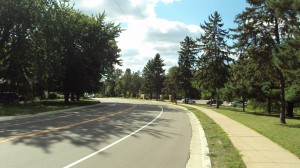The journalist in me says this would be a good time to back up and cover some of the W’s of lost golf courses. So here goes:
Who: Not a good “W” to start with, but I’ll get to it.
What: As in, “What is a lost golf course?” It’s any piece of land — or concrete, in a handful of instances — that once was a golf course but has been abandoned. That seems self-evident, so maybe it makes sense to detail what, in the case of my book, is not a golf course.
A course that has been redesigned or even rerouted in its original location is not a lost course.
A course that closed after the year 1999 is not a lost golf course, at least for the purposes of my book. I wanted the book to be historical in nature and leave readers saying, “Wow, I never knew there was a golf course there.” I know I did that more than once while researching. (Spring Grove? Mountain Iron? A state prison grounds?) Plus, there are so many lost courses since 1999 — must be at least a dozen just in the Twin Cities area — that I
didn’t want to make my lost-course project any more complicated than it already was.
The distinction between “golf clubs” and “golf courses” also should be noted. A golf club (no, not the implement used to propel a ball in mostly unintended directions) is an organization. A golf course is a tangible piece of land. A few Minnesota golf clubs still in existence operated what now are lost golf courses. Faribault is a notable example.
Where: All across Minnesota, from Warroad to Tower to Caledonia to Pipestone. Still, that “four corners” reference is a bit misleading. Minnesota’s lost courses weren’t sprinkled throughout the state so much as sprinkled through the north and north-central and “gobbed” in two areas — the Twin Cities metro (25 lost courses) and a swath across the very southern section of the state, from the South Dakota to Wisconsin borders (18 courses). That’s more than half of the state’s lost courses in just those two areas.
In the coming weeks, I’ll provide a link to an interactive map that shows locations of more than 80 Minnesota lost golf courses.
When: 1897 through 1999, hence the book’s subtitle. But there is a clear pattern of courses that were created in the 1920s and disappeared in the 1930s and ’40s.
Why: Two ways to look at that question …
— Why did they disappear? Many reasons, though there is one clear pattern that’s explained at length in the book. Or …
— Why did I write about them? Well, mostly because I found them damn fascinating.
The topic was not my idea. A fellow named Don Rohrer suggested it to the editors of Minnesota Golfer Magazine in 2010, and those editors approached me about writing about lost courses of the Twin Cities, which I did in the summer 2010 MN Golfer issue. I loved the assignment, everything about it. I met a gentleman named Don Dostert who gave me a wonderful motor tour around a lost golf course, Bunker Hills in Mendota Heights (no, that is not a typo. Minnesota’s original Bunker Hills golf course was in the south St. Paul suburb.). The idea bubbled around in my head for two years, until I decided to jump headlong into a book project in July 2012. The result is “Fore! Gone. Minnesota’s Lost Golf Courses, 1897-1999,” which I hope to have in print before the end of 2013.
Back to “Who?”: My favorite “W” of all, in the case of researching the book. I made hundreds of phone calls — 500 for sure, maybe more — trying to find people who knew about lost golf courses. That always was my main motivation — can I find someone who can tell me about the old double-dogleg at Westwood Hills or someone who lives on the old eighth fairway at Northwood? There were more misses than hits (and fewer misses, missuses and Ms.es than misters), but I struck gold more than once, with wonderful older folks like Mike Rak, an engaging 91-year-old who showed me every square foot of the old Hilltop Public Golf Links in Columbia Heights, then went home and sketched out a detailed, in-scale map of the lost layout.
By the way, that’s a view of the modern-day Hilltop grounds at the top of this post.
Latest posts by Joe Bissen (see all)
- Another lost routing: Hilltop, Columbia Heights - June 19, 2024
- Two lost routes: First, Antlers Park - June 17, 2024
- Tree trouble and townball: Naeseth Country Club, Wanamingo - May 6, 2024
